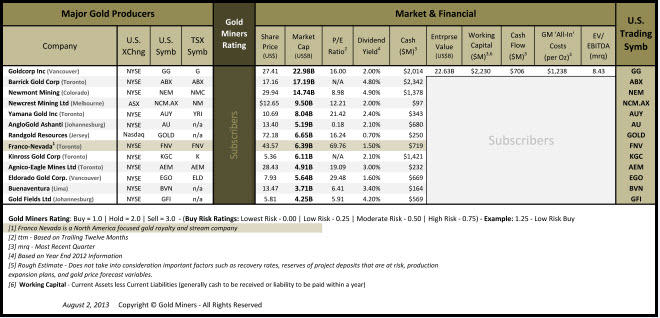Gold’s triple threat – Gold Miners weekly recap
Friday Aug 2, 2013
 For those of you who do not follow basketball, you may not know what a triple threat is. The triple threat is the best position an offensive player can be in because he has all possible options available to beat his defender. He can shoot, dribble, or pass. I’ll get back to this.
For those of you who do not follow basketball, you may not know what a triple threat is. The triple threat is the best position an offensive player can be in because he has all possible options available to beat his defender. He can shoot, dribble, or pass. I’ll get back to this.
Paper Market Troubles
However, since you are reading this, I will assume you follow the gold market. As such, you’ve probably read many recent headlines indicating that gold is in backwardation, GOFO rates are negative, gold exchange physical inventories are plummeting, and speculator short positions are the largest in COMEX history.
To put it mildly, when all of the above are taken together, they are suggestive of fairly strong physical demand and/or inadequate supply. The topics of backwardation and negative GOFO rates in particular have drawn thought provoking commentary from many distinguished gold market commentators.
Backwardation, using the London Bullion Market Association (LBMA) definition, is defined as a market situation where prices for future delivery are lower than the current spot price as a result of shortage or tightness of supply.
The Gold Forward Offered Rate (GOFO), again using the LBMA definition, is the rate that will induce contributors (i.e. bullion banks) to swap gold for US dollars. In a swap agreement both parties agree to return the swapped item at some date in the future.
The reason why these two topics have received so much attention is precisely because they rarely occur. And, when they have happened in the past, it has typically marked a major turning point in the price of gold.
Although we are eagerly waiting for history to repeat itself, which we will get to a little later, part of our discussion this week focuses on how these two rare and related phenomena are affecting the bullion banks.
The Bullion Banks
In simple terms, a bullion bank, much like an ordinary bank, holds gold on deposit on behalf of clients (like central banks) or themselves, and arbitrages the metal for profit while it is in their possession.
The four largest bullion banks are JP Morgan, HSBC, Deutsche Bank, and Scotia Bank.
Generally, bullion banks make money on gold by either lending it in the form of a swap agreement (earning the GOFO rate), selling a futures contract against the gold they own (earning the difference between the future price and the spot price), or selling gold in the physical market for a premium.
Whichever trade they choose is a function of which is the most profitable at the moment.
Currently the GOFO rate is negative, which makes the swap a relatively unattractive trade for bullion banks.
The GOFO rate has now been negative for an unprecedented 19 trading days and this has only happened on two prior occasions and then for a maximum of only 3 trading days.
Also, because of backwardation in certain delivery dates, selling futures contracts against gold, which the bullion banks may or may not have, is also unattractive.
Therefore, given the current gold market conditions outlined above, we think some important bullion banks are currently short physical gold and trying desperately to cover by sourcing as much physical gold as they can get.
There is anecdotal evidence of this in the Commitment of Traders Reports (COT) and the Bank Participation Reports (BPR). According to the BPR, during the 1st half of the year, the US bank category position changed from a net short position of 70,000 to a long position of 30,000 reflecting a change of 100,000 contracts.
This is an unprecedented shift in such a short period of time and is corroborated by a decline of 113,000 short contracts in the COT reports over the same period.
There are only 4 US banks indicated on the BPR report, and although they are not named, knowledgeable commentators indicate that JP Morgan is the primary actor in this massive shift from the short to long side of the ledger.
But please, keep this in mind; although the U.S. bullion banks are now net long, they are net long in paper futures contracts and not physical metal.
Unfortunately for them, some futures contracts dates are in backwardation and thus, not very profitable. To get their hands on physical gold, they have to jump in line with everyone else or turn to their favorite uncle.
Why isn’t the Gold Price Rising?
This brings us to the central question being asked by many observers in the gold market. If current physical demand for gold is so strong that it is causing a breakdown in the paper markets for gold, then why isn’t the price rising?
As we pointed out in last week’s recap, entitled “Gold Price Defies Law of Supply & Demand”, the gold price isn’t rising because there is massive selling coming from official government held gold reserves.
This assertion is supported by a comprehensive analysis prepared by Sprott Asset Management on behalf of their clients. It is based on official government records and research from respected industry groups.
We believe the decline in the gold price is a result of a combination of large scale shorting operations by major bullion banks along with large scale dishoarding of official U.S. gold holdings that have overwhelmed historic demand during the 1st half of this year.
This week, additional information hit the newswires from Alasdair MacLeod, chief analyst for GoldMoney, adding further fuel to the fire. His research on Bank of England (BoE) reporting of gold held in custody reveals a decrease of 1,300 tonnes of gold inventories between February and June of this year.
To put this in perspective, 1,300 tonnes is roughly equivalent to half of the entire of amount of annual gold production.
If we combine this new bit of information with the U.S. dishoarding of physical gold and the massive short selling in April by a U.S. bullion bank, it provides a reasonable explanation for why the gold price has been hammered this year, in spite of historic demand.
The Battle Lines are Drawn
If all of this is true, for a gold investor it is the equivalent to feeling like you are fighting against the heavyweight-boxing champion as a lightweight.
However we, along with many other gold market observers, are betting that the lightweight will prevail. Let’s survey the battle lines.
U.S. official gold reserves are reported as a little over 8,100 tonnes. If the Sprott report is correct, the true holdings are somewhere between 0 and 4,000 tonnes.
The BoE reported roughly 6,300 tonnes of gold held in custody in February and an app on their website now suggests this number has fallen by 1,300 tonnes in just 4 months.
Let’s be clear, England doesn’t own this gold, they only have 350 tonnes of their own reserves. The BoE is simply acting as custodian for other parties, which includes other central banks.
In light of the evidence, how much longer can the U.S. and U.K. stand in the breach, trying to hold down gold prices?
An interesting and related question is exactly whose gold did the U.K. sell and did they have their permission? Revelations this week about the BoE’s tarnished history in such matters suggests this might be a legitimate question to ask.
Now let’s briefly examine the forces of demand arrayed against these two stalwart gold sellers.
Bloomberg reports that The Shanghai Gold Exchange has supplied 1,098 metric tons of physical gold in the six months ending in June. This amount of gold is equivalent to 40% of annual global gold mine production. Should this rate of physical buying continue, China will consume the entire global mine supply by the end of the year.
This deserves repeating. By the end of this year, the Shanghai Gold Exchange will deliver the entire amount of annual global gold mine supply into China.
This rate of demand in conjunction with the rest of global demand cannot be met by mine production alone and is just further evidence that the source of supply flooding the market is coming from US and UK gold holdings.
In opposition, there are some commentators that believe this immense physical demand will not continue and the price of gold will fall further. We humbly disagree.
The Chinese government, in contrast to other governments of gold hungry countries such as India, encourages domestic gold investment at every level. They are also openly critical and directly affected by US monetary policies (e.g. QE) that are undermining the value of the dollar and U.S. Treasury debt.
The reason is because they hold a massive stockpile of US$’s and Treasury debt totaling roughly $2 trillion. For perspective, no other country even comes close to this figure. Japan is in a distant second place at roughly $1 trillion.
In the face of unfriendly US monetary policy, China is very likely taking advantage of low gold prices to exchange some of their US dollar based reserves for gold. Given the intense vulnerability of the U.S. fiscal situation to higher interest rates, it is unlikely that QE will end anytime soon. Ergo, neither will Chinese gold policy.
Conclusion
This begs the question; just how much gold can China buy? Let’s be conservative shall we? If China paid an average price of $2,500 per ounce, they could purchase 25,000 tonnes of gold, assuming it were available…which it’s not.
Thus, it is our straightforward conclusion that China’s unprecedented and unrelenting demand for physical gold will likely overcome the current supply glut in the not too distant future, regardless of its source. And this, in turn, will force the price of gold and the shares of gold miners higher.
Summing up this week’s discussion…we come back to the triple threat… gold’s paper markets have turned unprofitable, the U.S. bullion banks have repented and gone long, while China’s demand for gold will remain voracious for the foreseeable future.
In our view, team supply will not be able to withstand the onslaught of demand and a rising gold price should result.
Comparative Analysis Table
As always, we invite you to check out an abbreviated version of our Comparative Analysis Table. It compares the operations of 12 of the top gold producers as measured by market cap. It is a sampling of our in-house analysis customized to capture the key metrics of the gold mining business.
(Click the image to enlarge)
The complete table, available to subscribers, encompasses a long list of producers and a mountain of painstaking data gathering that we keep updated on a monthly, quarterly and annual basis as the information is released.
More News
{{ commodity.name }}
{{ post.title }}
{{ post.date }}


Comments